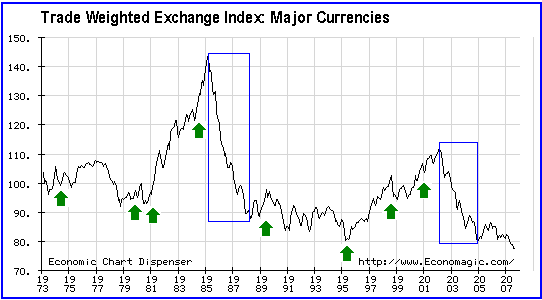|
|||
Fed rate cuts and the US$Steve Saville
A widely held opinion is that the Fed's decision to start cutting interest rates will put irresistible downward pressure on the US$ over the coming months. Later we'll point out one way in which this opinion could actually prove to be correct, but first we'll present evidence to show that the 'Fed-rate-cuts-will-soon-lead-to- additional-dollar-weakness' argument is not supported by the historical record. We have attempted to illustrate the relationship between Fed rate-reduction cycles and the US dollar's performance relative to other major currencies on the following long-term chart of the Trade Weighted Exchange Index (similar to, but not the same as, the Dollar Index). The arrows on the chart identify the STARTING points of the Fed rate-reduction cycles that have occurred since the beginning of the floating exchange-rate system (1973). Notice that significant US$ weakness has usually NOT occurred during the early stages of Fed rate-cutting campaigns. In fact, in most cases the US$ gained ground during the 6-12 month period following the Fed's first rate cut.  Does the above chart prove that interest rates aren't important drivers of currency exchange rates? In a word: no. Interest rate differentials are the dominant influence on intermediate-term trends in currency exchange rates, so if US interest rates continue to fall relative to interest rates elsewhere then the Dollar Index should eventually drop to lower levels. However, there are often substantial lags -- 6-12 months, or perhaps even longer -- between changes in interest rate trends and the resultant changes in currency exchange-rate trends. Also, it is the real interest rate rather than the nominal interest rate that matters, which means that a currency with a relatively low nominal interest rate can be persistently strong provided that this currency's expected loss of purchasing power is also relatively low. The aforementioned lag and the important role played by inflation expectations are probably why the relationship between interest rates and exchange rates is not straightforward. So, if history is anything to go by then the first 6-12 months of the current Fed monetary easing is more likely to be accompanied by US$ strength or stability than US$ weakness. As mentioned at the start of this discussion, though, there is at least one way in which the Fed's rate reductions could lead to significant additional US$ weakness over the coming months. That way would be for the Fed to continue its rate cutting in the face of an increasingly obvious inflation problem. In particular, if gold, commodity and equity prices stay firm over the next four weeks and the Fed still decides to cut its official target rate at the 31st October monetary policy meeting then the REAL Fed Funds rate will probably plunge due to a surge in inflation expectations. Such an outcome would almost certainly cause us to 'throw in the towel' on our short- and intermediate-term bullish views on the dollar because it would indicate that the Fed had abandoned all pretence of inflation fighting and had, instead, begun to pursue an OVERT policy of currency devaluation (presently, all the major central banks are pursuing COVERT currency devaluation policies). The Fed and the rest of the central banking establishment will eventually be left with no alternative other than to openly and aggressively devalue their currencies, but we don't think such drastic measures will be deemed necessary until next decade. Our expectation is that the Fed will NOT cut the Fed Funds rate again this year UNLESS sizeable declines in commodity and equity prices give it the cover to do so. While our main reason for including the above chart was to show how the US$ performed following the beginnings of previous Fed rate-cutting campaigns, it also serves to highlight a potential similarity between the US$ bear market that began in early 1985 and the current bear market. Notice that although the bear market beginning in 1985 did not reach its ultimate bottom until 1995, more than 80% of the peak-to-trough decline occurred during the bear market's first three years. We suspect that something similar has happened during the current bear market, which is why we recently upgraded our long-term US$ view from "bearish" to "neutral". Current Market Situation Our views are often linked. For example, our long-term bullish view on gold is inextricably linked to our long-term bearish view on the US stock market because secular trends in these markets must always be the opposite of each other (when gold's purchasing power is in a long-term upward trend the S&P500's purchasing power will necessarily be in a long-term downward trend, and vice versa). As a result of these linkages we will tend to be right about almost everything or almost nothing. Over the past seven years our long-term views have been completely right, but over the past three weeks our short-term views have been almost completely wrong. We've been wrong in the short-term because most of our short-term views have been linked to our expectation that a substantial US$ rally is about to begin. The Dollar Index has only fallen by around 3% over the past month, but that's been enough to prompt frenetic betting on the "Dollar collapse" scenario. We continue to anticipate a sizeable rally in the universally-reviled US$, but as mentioned above we will jettison our short- and intermediate-term bullish outlooks on this currency if the Fed cuts rates again in the face of surging equity and commodity prices. Steve Saville Regular financial market forecasts and analyses are provided at our web site: We aren't offering a free trial subscription at this time, but free samples of our work (excerpts from our regular commentaries) can be viewed at: http://tsi-blog.com Saville Archives |
